Related Research Articles

Jefferson Finis Davis was an American politician who served as the president of the Confederate States from 1861 to 1865. As a member of the Democratic Party, he represented Mississippi in the United States Senate and the House of Representatives before the American Civil War. He previously served as the United States Secretary of War from 1853 to 1857 under President Franklin Pierce.

The Democratic-Republican Party, also referred to as the Jeffersonian Republican Party and known at the time under various other names, was an American political party founded by Thomas Jefferson and James Madison in the early 1790s that championed republicanism, political equality, and expansionism. The party became increasingly dominant after the 1800 elections as the opposing Federalist Party collapsed. The Democratic-Republicans later splintered during the 1824 presidential election. The majority faction of the Democratic-Republicans eventually coalesced into the modern Democratic Party, while the minority faction ultimately formed the core of what became the Whig Party.

The United States Military Academy (USMA), also known as West Point, Army, Army West Point, The Academy, or simply The Point, is a four-year federal service academy in West Point, New York. It was originally established as a fort, as it sits on strategic high ground overlooking the Hudson River with a scenic view, 50 miles (80 km) north of New York City. It is the oldest of the five American service academies and educates cadets for commissioning into the United States Army.

The 1828 United States presidential election was the 11th quadrennial presidential election. It was held from Friday, October 31 to Tuesday, December 2, 1828. It featured a rematch of the 1824 election, as President John Quincy Adams of the National Republican Party faced Andrew Jackson of the Democratic Party. Both parties were new organizations, and this was the first presidential election their nominees contested. Jackson's victory over Adams marked the start of Democratic dominance in federal politics.

Alexander Hamilton was a Caribbean-born American statesman, politician, legal scholar, military commander, lawyer, banker, and economist. He was one of the Founding Fathers of the United States. He was an influential interpreter and promoter of the U.S. Constitution, as well as the founder of the nation's financial system, the Federalist Party, the United States Coast Guard, and the New York Post newspaper. As the first secretary of the treasury, Hamilton was the main author of the economic policies of President George Washington's administration. He took the lead in the federal government's funding of the states' debts, as well as establishing the nation's first two de facto central banks, a system of tariffs, and friendly trade relations with Britain. His vision included a strong central government led by a vigorous executive branch, a strong commercial economy, support for manufacturing, and a strong military.

Robert Endre Tarjan is an American computer scientist and mathematician. He is the discoverer of several graph algorithms, including Tarjan's off-line lowest common ancestors algorithm, and co-inventor of both splay trees and Fibonacci heaps. Tarjan is currently the James S. McDonnell Distinguished University Professor of Computer Science at Princeton University, and the Chief Scientist at Intertrust Technologies Corporation.
Thomas Jefferson University is a private research university in Philadelphia, Pennsylvania. Established in its earliest form in 1824, the university officially combined with Philadelphia University in 2017. To signify its heritage, the university sometimes carries the nomenclature Jefferson in its branding. It is classified among "R2: Doctoral Universities – High research activity".
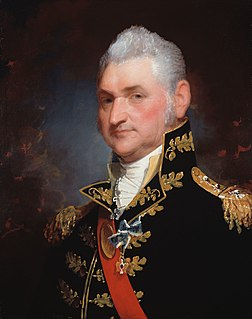
Henry Dearborn was an American soldier and statesman. In the Revolutionary War, he served under Benedict Arnold in the expedition to Quebec, of which his journal provides an important record. After being captured and exchanged, he served in George Washington's Continental Army. He was present at the British surrender at Yorktown. Dearborn served on General Washington's staff in Virginia.
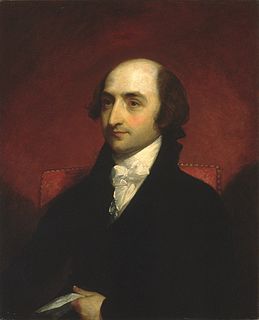
Abraham Alfonse Albert Gallatin, born de Gallatin was a Genevan-American politician, diplomat, ethnologist and linguist. Biographer Nicholas Dungan states that Gallatin was "America's Swiss Founding Father." He is known for being the founder of New York University and for serving in the Democratic-Republican Party at various federal elective and appointed positions across four decades. He represented Pennsylvania in the Senate and the House of Representatives before becoming the longest-tenured United States Secretary of the Treasury and serving as a high-ranking diplomat.

William Maclure was an Americanized Scottish geologist, cartographer and philanthropist. He is known as the 'father of American geology'. As a social experimenter on new types of community life, he collaborated with British social reformer Robert Owen, (1771–1854), in Indiana, United States.

Robert Adrain was an Irish mathematician, whose career was spent in the USA. He was considered one of the most brilliant mathematical minds of the time in America, during a period when few academics conducted original research. He is chiefly remembered for his formulation of the method of least squares.

Rufus Putnam was a colonial military officer during the French and Indian War, and a general in the Continental Army during the American Revolutionary War. As an organizer of the Ohio Company, he was instrumental in the initial settling of the Northwest Territory in present-day Ohio following the war.
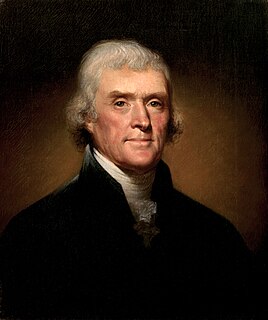
Thomas Jefferson served as the president of the United States from March 4, 1801 until March 4, 1809. Jefferson assumed the office after defeating incumbent President John Adams in the 1800 presidential election. The election was a political realignment in which the Democratic-Republican Party swept the Federalist Party out of power, ushering in a generation of Democratic-Republican dominance in American politics. After serving two terms, Jefferson was succeeded by Secretary of State James Madison, also of the Democratic-Republican Party.
Forrest McDonald was an American historian who wrote extensively on the early national period of the United States, republicanism, and the presidency, but he is possibly best known for his polemic on the American South. He was a professor at the University of Alabama, where, together with Grady McWhiney, he developed the hypothesis that the South had been colonized by "Anglo-Celts," rather than the British Protestant farmers who populated the North.
Robert Henry Kirkwood was a United States officer who fought in the American Revolutionary War and the Northwest Indian War. He died in 1791 during the battle of St. Clair's Defeat.
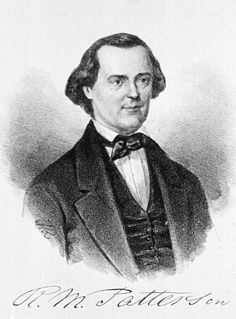
Robert Maskell Patterson was an American chemist, mathematician, and physician. He was a professor of mathematics, chemistry and natural philosophy at the University of Pennsylvania and professor of natural philosophy at the University of Virginia. He also served as director of the United States Mint and as president of the American Philosophical Society.

Arthur Sherburne Hardy or Arthur S. Hardy was an American engineer, educator, editor, diplomat, novelist, and poet.

The presidency of George Washington began on April 30, 1789, when Washington was inaugurated as the first president of the United States, and ended on March 4, 1797. Washington took office after the 1788–89 presidential election, the nation's first quadrennial presidential election, in which he was elected unanimously. Washington was re-elected unanimously in the 1792 presidential election, and chose to retire after two terms. He was succeeded by his vice president, John Adams of the Federalist Party.
George Baron was a mathematician who emigrated from Northumberland, England to Hallowell, Maine in the United States, thereafter moving to New York. He was the first superintendent and mathematics professor at what would become the United States Military Academy in 1801 and the founder and editor-in-chief of the Mathematical Correspondent, which was the first American "specialized scientific journal" and the first American mathematics journal, first published May 1, 1804.
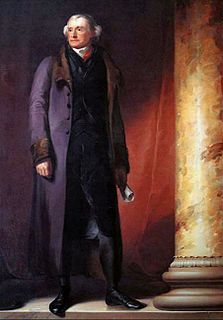
The Military Peace Establishment Act documented and advanced a new set of laws and limits for the U.S. military. It was approved by Congress and signed on March 16, 1802, by President Thomas Jefferson, who was fundamental in its drafting and proposal. The Act outlined in 29 sections the rules, the number of officers and military personnel and the management of provisions that would be granted to the military overall. The Act also directed that a corps of engineers be established and "stationed at West Point in the state of New York, and shall constitute a Military Academy" whose primary function was to train expert engineers loyal to the United States and alleviate the need to employ them from foreign countries. Jefferson also advanced the Act with political objectives in mind.
References
- ↑ Wagoner Jr., Jennings L.; McDonald, Christine Coalwell (2004). "Mr. Jefferson's Academy: An Educational Interpretation.". In McDonald, Robert M.S. (ed.). Thomas Jefferson's Military Academy: Founding West Point. University of Virginia Press. p. 151 n. 45. ISBN 0-8139-2298-4.
- ↑ Cajori, Florian (1890). The Teaching and History of Mathematics in the United States. Washington: Government Printing Office. p. 94.
- ↑ MacTutor bio of Robert Adrain, which contains journal info